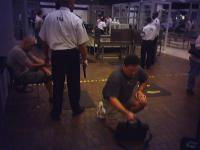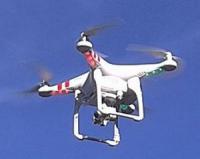-
Airport body scanners fail to provide promised security
Since 2008, the Transportation Security Administration (TSA) has spent $160 million on scanners to identify passengers which may be carrying weapons. These scanners, however, do not perform as well as was originally believed.Independent audits have found that the system provides weak protection against determined adversaries.A display of the mock weapons and explosives whichthat investigators were able to get through the scanners included various size folding knives, a kitchen knife, explosive-less hand grenades, a handled awl, a lighter, handguns, ammunition, a shotgun shell, various bludgeons, and a nunchaku.
-
-
U.S., Canada, Mexico create North American Trusted Traveler network

DHS said it has joined Public Safety Canada and the Secretariat of Governance of Mexico in outlining the first steps toward the creation of a North American Trusted Traveler network. The new agreement, signed on 10 July 2015, will make it easier for eligible travelers in the United States, Mexico, and Canada to apply for expedited screening programs. Eligible travelers will be able to apply for each program beginning in 2016.
-
-
D.C. security gaps exposed by gyrocopter landing on Capitol grounds: Senate panel
A Senate committee has concluded that the Florida man who flew a one-man gyrocopter and landed it on the U.S. Capitol grounds, had exposed security gaps and inadequate coordination among the agencies charged with protecting the Capitol, the White House, and other Washington landmarks. In addition to calling for better coordination among the different agencies responsible for securing important sites in Washington, D.C., the committee strongly recommends seeking new “technological solutions” to spot similar flights in the future, suggesting that Congress should also consider increasing penalties for those who breach the restricted airspace.
-
-
New air traffic management system to make drone air traffic safer

Researchers are now working on a new, low-altitude traffic management system to keep fast-moving flyers safer as they cruise through increasingly crowded skies. A handful of organizations are participating in the first phase of the NASA Ames Unmanned Aerial Systems Traffic Management project to enable safer use of low-altitude airspace, of 500 feet and below, where autonomous aerial vehicles, helicopters, gliders, and other general aircraft are operating.
-
-
Bomb-proof lining contains explosion in aircraft’s luggage hold
A bomb-proof lining developed by an international team of scientists has successfully contained blasts in a series of controlled explosions in the luggage hold of a Boeing 747 and an Airbus 321. The Fly-Bag, which lines an aircraft’s luggage hold with multiple layers of novel fabrics and composites, was tested last week under increasing explosive charges on disused planes. The tests, using this technology, have demonstrated that a plane’s luggage hold may be able to contain the force of an explosion should a device concealed within a passenger’s luggage be detonated during a flight.
-
-
Cyberjacking may be the new threat to air travel
We accept lengthy queues in airport security as a small price to pay for a couple of weeks in the sun. Could the latest threat to air travel, however, be something that cannot be picked up by metal detectors and X-ray machines? Is cyberjacking — hacking into a plane’s computer systems — a possibility? Researchers warn that it is possible. There is no need to cancel that holiday just yet, however.
-
-
MH370 Boeing 777 nosedived to the ocean floor: Mathematicians
The plight of Malaysia Airlines flight 370 (MH370) is one of the biggest mysteries in aviation history, but now an interdisciplinary research team has theorized the ill-fated plane plunged vertically into the southern Indian Ocean in March 2014. The researchers used applied mathematics and computational fluid dynamics to conduct numerical simulations of a Boeing 777 plunging into the ocean, a so-called “water entry” problem in applied mathematics and aerospace engineering. They say that based on all available evidence — especially the lack of floating debris or oil spills near the area of the presumed crash — the mostly likely theory is that the plane entered the water at a vertical or steep angle.
-
-
TSA failed to identify 73 employees potentially associated with terrorism
The Department of Homeland Security Office of Inspector General (OIG) yesterday released a report on TSA’s controls over the vetting of aviation workers who apply for credentials allowing unescorted access to secured airport areas. The TSA repeatedly screens about two million airport workers, but OIG says that the agency failed to identify seventy-three workers potentially associated with terrorism. One reason for this slip: the DHS watch-list, against which the TSA checks airline and airport applicants and workers, is not as comprehensive as the government’s terrorist database. TSA says it will begin to check applicants and employees against the broader list by the end of the year.
-
-
Airport screeners missed 95% of mock explosives, weapons in tests; TSA acting director removed
Following reports that screenings failed to detect mock explosives and weapons, carried out by undercover agents in tests, in 95 percent of cases, DHS secretary Jeh Johnson has ordered improved security at airports and reassigned Melvin Carraway, acting administrator of the TSA, to another role. DHS IG, in a forthcoming report, says that airport screeners, employed by TSA, did not detect banned weapons in 67 out of 70 tests at dozens of U.S. airports.
-
-
Could better tests have predicted the rare circumstances of the Germanwings crash? Probably not
When people do terrible things, it seems reasonable to believe we should have taken steps to identify them beforehand. If we can do that, then surely we can prevent them from doing harm. The crash of Germanwings Flight 9525 in March, which appears to have been an intentional act, is an example. It shocks us (and understandably so) when a trusted professional harms those who have entrusted their lives to him or her. So why not identify pilots at risk and take steps to prevent similar events from ever occurring again? Because it is likely impossible, and maybe even counterproductive. The limits of what can be achieved in predicting an event represent a dilemma we face all the time in biomedical testing. It may be possible to prevent rare events such as the Germanwings tragedy — “smart” cockpit doors or some such technological solution. But predicting their occurrence by looking more closely at the individuals involved is doomed to fail.
-
-
Better detection of diseases, fraudulent art, chemical weapons, and more
From airport security detecting explosives to art historians authenticating paintings, society’s thirst for powerful sensors is growing. Given that, few sensing techniques can match the buzz created by surface-enhanced Raman spectroscopy (SERS). Discovered in the 1970s, SERS is a sensing technique prized for its ability to identify chemical and biological molecules in a wide range of fields. It has been commercialized, but not widely, because the materials required to perform the sensing are consumed upon use, relatively expensive and complicated to fabricate. That may soon change.
-
-
How a hacker could hijack a plane from their seat
Reports that a cybersecurity expert successfully hacked into an airplane’s control system from a passenger seat raises many worrying questions for the airline industry. It was once believed that the cockpit network that allows the pilot to control the plane was fully insulated and separate from the passenger network running the in-flight entertainment system. This should make it impossible for a hacker in a passenger seat to interfere with the course of the flight. But the unfolding story of this hacker’s achievement, which has prompted further investigation by authorities and rebuttals from plane manufacturers, means that this assumption needs to be revisited.
-
-
Airlines ban shipments of lithium-ion batteries following cargo fires
Rechargeable lithium-ion batteries may soon have to be imported by other means than air shipments after at least eighteen airlines have banned shipments of the product this year following devastating cargo fires such as the one that caused a United Parcel Service (UPS) freighter to crash near Dubai in 2010. Roughly 30 percent of the 5.5 billion cell batteries produced each year are shipped by plane.
-
-
New airport security technologies raise privacy concerns
Researchers are developing surveillance technologies better to help airport security officials scan passengers and luggage for contraband and suspicious behavior. Privacy advocates say these expensive and ambitious projects, meant to increase public safety and ease air travel delays, risk intruding on passengers’ privacy.“What starts in the airport doesn’t stay there,” says a technology expert at the ACLU.
-
-
A very big concept lifts off
In 2010, a group of defense contractors led by Northrop Grumman received a contract from the U.S. Department of Defense to create a so-called Long Endurance Multi-Intelligence Vehicle (LEMV) — a super-sized surveillance aircraft that had the capability of spending days in the air on a single mission. The first test flight of the Airlander took place in August 2012. In 2013, however, budget cuts led to the cancellation of the project, and U.K.-based Hybrid Air Vehicles (HAV), which was part of contractors group, bought the Airlander back from the DoD at effectively scrap value. So the Airlander came back to the United Kingdom, where it lives in a giant hangar in Cardington, Bedfordshire. It is there because it is the only place in the United Kingdom that can house it, having been built for airship manufacture in 1915. HAH has big plans for it.
-
More headlines
The long view
Prototype Self-Service Screening System Unveiled
TSA and DHS S&T unveiled a prototype checkpoint technology, the self-service screening system, at Harry Reid International Airport (LAS) in Las Vegas, NV. The aim is to provide a near self-sufficient passenger screening process while enabling passengers to directly receive on-person alarm information and allow for the passenger self-resolution of those alarms.
